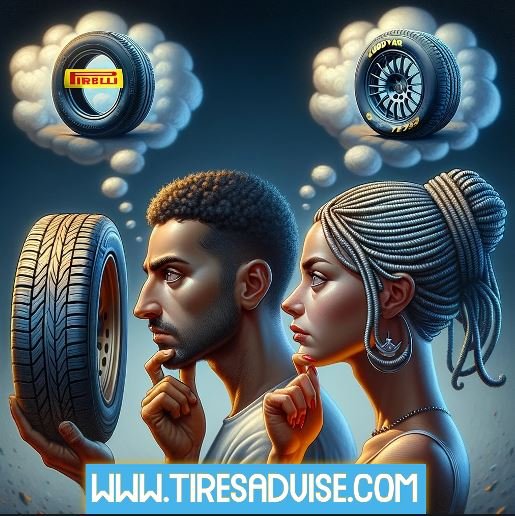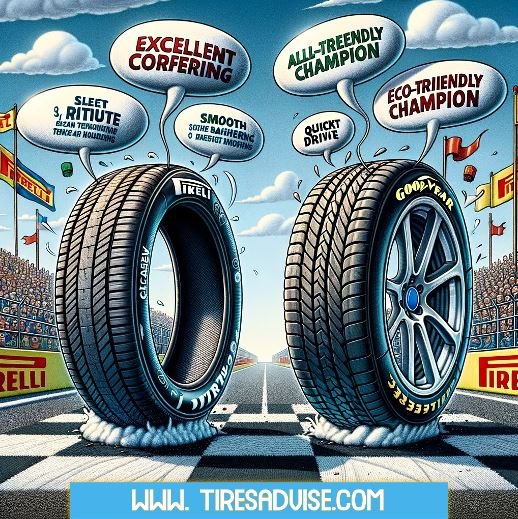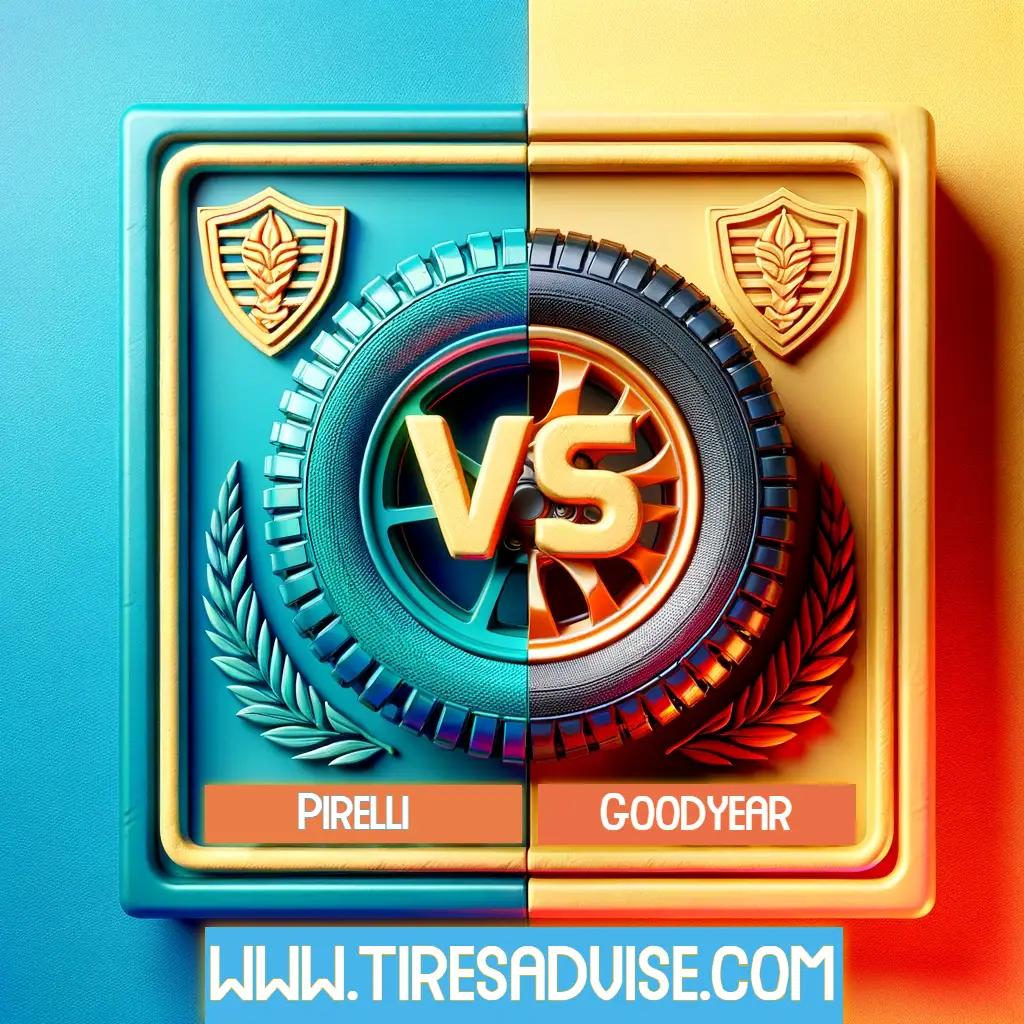Navigating the world of tires can feel like deciphering a foreign language. It’s not just about rubber meeting the road; it’s about how that rubber is crafted and the purpose behind its design.
Let’s take two giants in the tire industry: Pirelli and Goodyear.
Pirelli specializes in manufacturing tires for sports and luxury vehicles, offering improved handling and performance with improved short-braking distance. On the other hand, Goodyear leans towards the eco-conscious, crafting tires that favor fuel efficiency, a boon for SUVs and truck aficionados.
It’s akin to choosing between a sleek sports car and a robust off-roader. Both have their merits, and both cater to specific needs.
So, whether you’re gunning for speed on the highway or aiming for that extra mile on a gallon, understanding the nuances between these two brands can be your roadmap to making an informed decision.
Historical Overview of Pirelli and Goodyear Tires
Tracing the legacies of Pirelli and Goodyear takes us on a journey through time, highlighting their pioneering spirit and relentless pursuit of excellence. From the bustling streets of Milan to the industrious heart of Akron, Ohio, these two giants have shaped the tire industry, leaving an indelible mark with their innovations and commitment to quality.
Origins of Pirelli
Pirelli, a gem from Italy, was birthed by the visionary Giovanni Battista Pirelli in 1872. Starting as a modest venture named “G.B. Pirelli & C.” in Milan, it wasn’t long before the brand carved its niche. Pirelli soon became a beacon of tire innovation, introducing groundbreaking products like the Cinturato radial tire.
The early 20th century was a period of rapid expansion for Pirelli. They planted their flag in various global locations, from Barcelona in 1902 to Buenos Aires by 1917. Fast forward to today, and Pirelli’s legacy stretches across 150 countries, continuing to set the gold standard in tire excellence.
Goodyear’s Foundational Years
Across the Atlantic, Goodyear emerged as a stalwart in the American tire landscape. Founded in 1898 by the industrious Frank Seiberling, Akron, Ohio became the birthplace of this tire giant. Goodyear wasn’t just about producing tires; they were about revolutionizing them.
Innovations like Duraseal, which effectively seals tread punctures, and the robust ArmorGrip Technology using Kevlar, showcased their commitment to excellence. Their tire range is vast, catering to diverse needs from monster trucks to everyday SUVs.
Similarities between Pirelli and Goodyear tires
Pirelli and Goodyear’s tires have several similarities. Let’s have a look at them.
- Both Pirelli and Goodyear shine when it comes to performance. Whether you’re driving on a sun-drenched highway or navigating a rain-soaked city street, these tires hold their ground. Even off-road adventurers can trust these brands to deliver a smooth ride.
- Variety is the spice of life, and both these tire giants understand that. They cater to a broad spectrum of vehicles. Whether you’re behind the wheel of a sleek sports car, a rugged SUV, a dependable truck, or a cozy family sedan, both brands have got you covered.
- Ever had that sinking feeling of a flat tire in the middle of nowhere? Both Pirelli and Goodyear have tackled this challenge head-on. They’ve integrated run-flat technology into their tires. This means even if you get a puncture, you can still drive a certain distance to get it fixed.
- Peace of mind is priceless. Recognizing this, both brands back their products with robust warranty programs. So, if you ever face an issue, you can rest easy knowing they’ve got your back.

Differences between Pirelli and Goodyear tires
Pirelli and Goodyear are two well-known tire manufacturers that provide high-quality tires. Based on the search results, the following are the likely differences between the two brands:
1. Tread Life
The longevity of a tire is often a key consideration for buyers. Pirelli promises impressive tread life, with some of their tires boasting longevity of up to 65,000 miles. This is a testament to their commitment to quality and durability.
Goodyear offers a tread life warranty that typically covers up to 50,000 miles. It’s essential to note that while warranties provide a guideline, actual tread life can vary based on driving conditions and maintenance.
Some users have pointed out that certain Pirelli tires wore out faster than anticipated, sometimes clocking mileage in the teens.
2. Price
In the world of tires, the price often reflects the brand’s positioning, technology, and target audience. Pirelli, known for its premium offerings, generally commands higher prices. Their entry-level tires start at around $135, reflecting their focus on luxury and performance.
Goodyear, with its diverse range, offers more budget-friendly options. Their tires can start as low as $61, making them accessible to a wider audience without compromising on quality.
3. Technology
Innovation drives the tire industry, and both Pirelli and Goodyear are at the forefront. While both brands have adopted run-flat technology, allowing drivers to continue driving for a limited distance after a puncture, they have distinct technological advancements.
Pirelli’s Noise Canceling System (PNCS) is a testament to their commitment to driver comfort, producing tires that significantly reduce road noise. Goodyear, with its Duraseal technology, offers a solution to tread punctures, ensuring minor punctures don’t become major inconveniences.
Additionally, their ArmorGrip Technology, which incorporates the strength of Kevlar, adds an extra layer of durability to their tires.
4. Variety
Variety caters to the diverse needs of drivers. Goodyear, with its extensive range, offers something for everyone. From the reliable Goodyear Assurance for every day driving to the rugged Goodyear Wrangler for off-road adventures, their portfolio is vast.
Pirelli, while having a more curated range, doesn’t lag. Their lineups, such as the Pirelli Carrier for cargo vehicles or the Pirelli Scorpion for off-roading, are tailored to specific driving needs, ensuring optimal performance.
5. Partnerships
Strategic partnerships often highlight a brand’s prestige and expertise. Pirelli, with its high-performance tires, is the chosen original equipment (OE) for luxury auto giants like Ferrari, Bentley, and Lamborghini.
This association underscores its excellence in the luxury automotive segment. Goodyear, with its racing DNA, is the official tire partner of NASCAR. Their expertise in crafting high-performance racing tires is unparalleled, but they also cater to the daily commuter with their versatile all-season range.
6. Warranty
Warranties are a testament to a brand’s trust in its products. Both Pirelli and Goodyear offer comprehensive warranty programs, but with distinct nuances:
They provide a three-pronged warranty approach: a warranty on tread life, a warranty on defects, and a 30-day return policy, ensuring customers are covered from multiple angles.
Pirelli also offers a trio of warranties. However, their tread life warranty comes with a catch: tire rotation is required every 6,000 to 8,000 miles to maintain the warranty’s validity.
7. Dry Conditions
Known for their exceptional grip on dry roads, Pirelli tires are engineered to handle power and deliver rapid stops, outperforming many other brands in this aspect.
Goodyear tires are designed for a smooth drive on dry tracks. They excel in providing reliable traction, and grip, and are responsive to braking, ensuring a safe driving experience.
8. Wet Conditions
Both brands perform admirably in wet conditions. Pirelli’s Scorpion Verde All-Season tires stand out, especially when driving high-performance cars in the rain. They offer superior performance levels on wet roads, ensuring a comfortable and safe ride.
Goodyear has a range of tires tailored for wet weather driving. They ensure good traction and safety, making them a reliable choice for regular cars during rainy conditions.

Tabular Comparison between Pirelli and Goodyear Tires
| Sr. No | Feature | Pirelli | Goodyear |
| 01 | Performance | Specializes in luxury and sports cars, offering enhanced traction, handling, and short braking distance. | Focuses on eco-friendly and fuel-efficient tires, suitable for SUVs and trucks. |
| 02 | Tread Life | Offers longer tread life, up to 65,000 miles, but some users report faster wear. | Tread life warranty covers up to 50,000 miles. |
| 03 | Price | Generally more expensive, with entry-level offerings starting around $135. | More budget-friendly, with prices starting as low as $61. |
| 04 | Technology | Features run-flat technology and Pirelli Noise Canceling System (PNCS) for quieter tires. | Incorporates run-flat technology, Duraseal for sealing punctures, and ArmorGrip with Kevlar for durability. |
| 05 | Variety | A more curated range focusing on specific driving needs like Pirelli Carrier and Pirelli Scorpion. | Broader selection, including Goodyear Assurance and Goodyear Wrangler, catering to a wide range of vehicles. |
| 06 | Partnerships | OE tires for luxury brands like Ferrari, Bentley, and Lamborghini. | Official partner of NASCAR, with a range extending to everyday commuter tires. |
| 07 | Warranty | Offers three types of warranties, with mandatory tire rotation every 6,000 to 8,000 miles for tread life warranty. | Provides three types of warranties, including a tread life warranty, a defect warranty, and a 30-day return policy. |
| 08 | Performance in Dry Conditions | Excel at gripping the road and handling power, with faster-stopping capability. | Provide smooth driving, good traction, grip, and swift response to braking. |
| 09 | Performance in Wet Conditions | Offers excellent performance, particularly with Scorpion Verde All-Season tires in high-performance cars. Known for superior performance and comfort on wet roads. | Ensure good traction and safety in wet weather, suitable for regular cars. |
Conclusion
In the world of tires, Pirelli and Goodyear stand as two titans, each with its distinct strengths and offerings. Pirelli, with its Italian heritage, excels in the luxury and sports car segment, ensuring superior traction and handling.
Goodyear, on the other hand, leans towards eco-friendliness and offers a broader selection suitable for various vehicles. While both brands promise durability and performance in both dry and wet conditions, their technological innovations, price points, and warranties differ.
In essence, the choice between Pirelli and Goodyear boils down to individual preferences and specific driving needs. Both brands, with their rich histories and commitment to quality, ensure that drivers are in good hands on the road.

